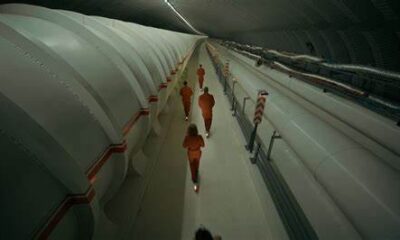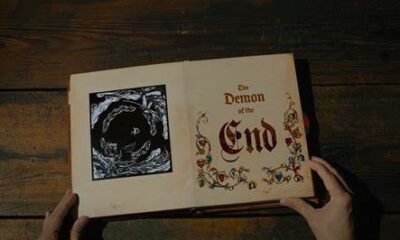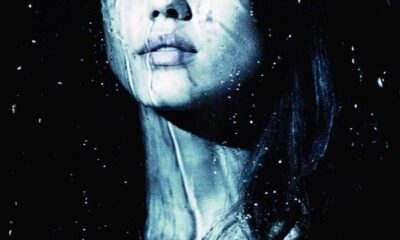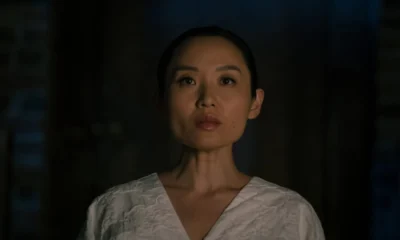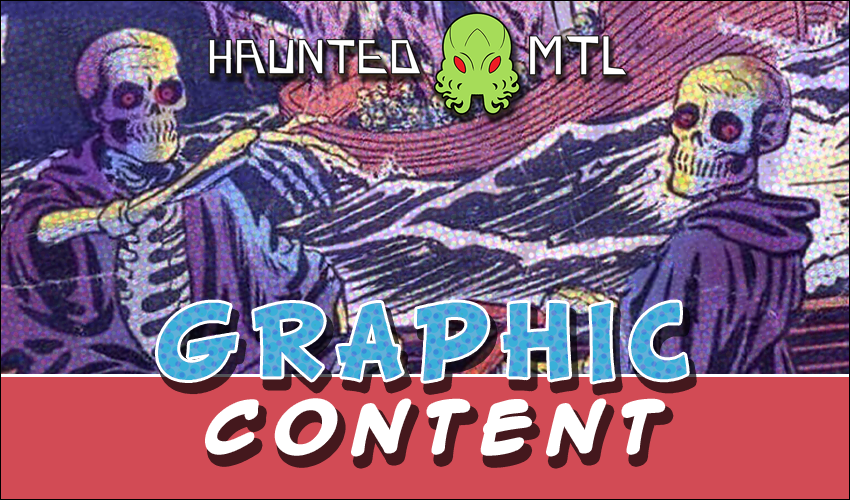
Graphic Content #3
Welcome back to Haunted MTL’s ongoing horror comic review feature, Graphic Content. In our third installment, we’ll be keeping up with John Constantine: Hellblazer, Killadelphia, and Sink.
We’re always on the lookout for new titles to cover, so leave your suggestions in the comments.
John Constantine: Hellblazer #5

This issue we continue to spend time with John’s current generation of characters while also dipping back into the past. For fans of Vertigo’s run, a familiar set of names should prove exciting. It has been fun to see the new-world magic butt up against John’s old-world magic. Even back then, however, John was a rebel, so his positionality in the magic world allows him to bridge a gap and highlight what seems to be the idiosyncrasies of both eras in a fun way.
John’s old Vertigo-era contact, Clarice Sackville, pops up to let John know about something key, a prophecy of sorts: the final death of John Constantine is approaching. Particularly entertaining is Clarice playing on John’s ego with expertise. As for Map’s fate, we’ll need to stick around for more information.
Also enjoyable? John’s frustration with Tommy Willowtree. What is especially fun is the polyamorous representation in the book with John, not a stranger from sampling carnal delights from anywhere he can take them, even a bit shocked by Willowtree’s more modern concept of relationships.
What has been most fun about this current arc is a sense of growth in John. When it comes to comics from “the Big Two” progression in characterization is often something that is temporary at best, and non-existent at worst. With John Constantine: Hellblazer, we’ve managed to see John grow in significant ways, and this issue may be the most substantial example of that with him putting aside his own crap and supporting someone else that is not an immediate benefit to himself.
This is, unfortunately, the last issue with Matías Bergara on art duty. His style may not be what one immediately thinks of for Hellblazer, but I appreciate the look and it worked perfectly well for what the story was. It wasn’t necessarily that this arc, “Scrubbing Up” was a light sort of story, but it was certainly a bit more whimsical than what one may expect. Bergara’s work was solid and he is definitely in a short-list of artists I would love to see on the book again.
Five issues into Hellblazer and I am still very much looking forward to each and every installment.
 (5 / 5)
(5 / 5)
John Constantine: Hellblazer #5 was written by Simon Spurrier, illustrated by Matías Bergara, and colored by Jordie Bellaire.
Note: As of this installment of Graphic Content, John Constantine: Hellblazer #5 does not seem to be listed on DC’s website.
Killadelphia #6
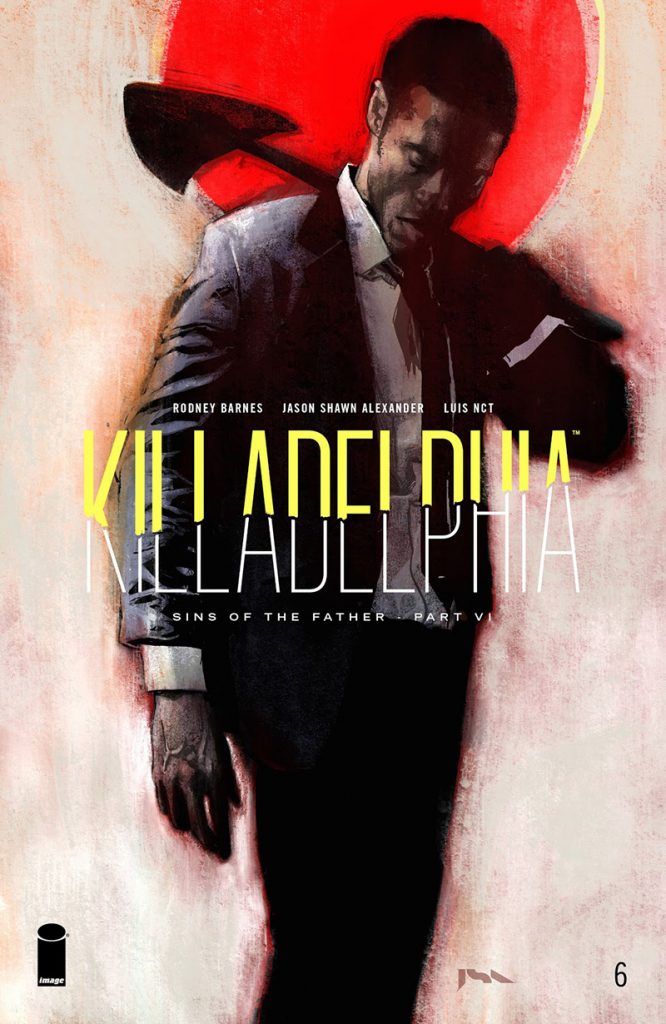
We conclude the first arc of Killadelphia with this sixth issue, “Sins of the Father Part VI, For God and Country.” Does one of my favorite horror comics around stick the landing?
Overall, yes it does. This issue does a great job of presenting a level of finality while leaving the series open to move forward, as one would hope. Yet, I have my quibbles, but it is fairly minor stuff. My main concern is the vampiric “battle” that wraps up Adams, John Sr., and Tevin’s plotlines. I’m not really a fan of big, flashy vampiric powers and while I think Killadelphia as a whole presented some great vampires, I am not the biggest fan of what feels like a DragonBall Z kind of beam combat. It just doesn’t feel appropriate for the tone of the book.
Also, having the complete volume, I can safely say that I wish the series was a little less compressed. Specifically, I think two more issues might have fixed some overall pacing that I see going on now with the entirety of the volume available. This is all hindsight, of course.
What I am intrigued by most regarding this issue, though, is where it leaves the series going forward. Two particularly key figures seem to be gone, now, and while I am concerned about their absence, I am also intrigued by the potential in the shakeup of the world. Particularly given the rather public appearance of the vampires as the book progressed. This has the chance to really alter the landscape of the book and Philadelphia itself. Overall, as a first volume, it is very satisfying and I am very much eager to read volume two.
From what I have gathered, Jason Shawn Alexander will be continuing art duties going into volume two, and I am highly pleased by that. I’ve written quite a lot about Rodney Barnes’ storytelling here, but Jason Shawn Alexander’s artwork is a pretty perfect vehicle for what Barnes is doing. In one of my first reviews of the series I spoke about a level of grittiness to the artwork, and the series has not only kept that consistent but also refined it. This is a great looking book, and volume two should maintain that trend.
I also should mention the great coloring choices by Luis Nct. The palette is very subtle with a heavy emphasis on reds, as one would expect from a vampire book, but the usage of those reds is particularly skillful across the first volume.
It’s going to stink not having Killadelphia to read in my monthly pull from my local comic shop (shout out to Digger’s Comics!) but I am glad there will be more in the near future. As a whole, I think the first volume stands out as one of the best vampire comics I have ever read, despite some minor issues I had here and there.
 (4 / 5)
(4 / 5)
Killadelphia #6 was written by Rodney Barnes, illustrated by Jason Shawn Alexander, and colored by Luis Nct.
Sink #2

I enjoyed how utterly messed up the first issue of Sink was to keep reading it. Sink #2, “The Door at the End,” is more of the same, so your own mileage may vary if you would be down for it. For someone like me, it is a perfectly fun comic. I am still having a little trouble with some of the Glasgowisms present, but we can chalk that up to my being an ignorant American.
The series, at least going off of the first two issues, feels anthologized. Different slices of a fucked up, hyper-violent Glasgow. This time around we follow the fallout of a Ménage à trois gone horribly, violently wrong through the perspective of a new character. This new character, Sharon, is a fixer of sorts who hails from Sink Hill, the neighborhood that gives the series its name. She arrives to dispose of a corpse.
Only what was dead doesn’t seem to stay dead in this case. Or does it? What follows is a dance party with an apparently homeless man, a discussion of a really messed up dream, and a surprisingly effective fake-out.
It’s all very moody stuff but there is a certain catharsis in that. Sink isn’t a feel-good story and among the selections in this installment of Graphic Content it has the distinct vibe of feeling hopeless, in a way. That’s not a bad thing though. Sink seems to be a series of feel bad stories but that is not meant to disparage what is going on in them as the stories are very much rooted in exploring trauma… just violently. John Lees seems to be looking at a very damaged place that just seems to try to sort that damage by inflicting more damage and it’s a good read. Very sad, but good.
Alex Cormack’s art is well suited to this type of storytelling. It’s a broader, cartoonier style than Jason Shawn Alexander’s work in Killadelphia, but it has the same sort of overall grunginess. Sink is a rough read about a rough place, and the visuals are just as rough. It all fits.
Overall, Sink is shaping up to be a fun anthology series. It’s definitely made for an interesting portrait of Sink Hill over the course of two issues, and it makes one wonder what other stories lurk in that seedy, violent neighborhood.
 (4.5 / 5)
(4.5 / 5)
Sink #2 was written by John Lees and illustrated and colored by Alex Cormack.
With Killadelphia on a break, looking forward to a new title entering the mix with Graphic Content #4.
Agree or disagree with the reviews? Have a title you think I should cover? Let us know in the comments.
Book Reviews
A Stellar Debut Novel, We Used To Live Here
Imagine this. You’re home alone, waiting for your partner to return, when you hear a knock on your door. You answer it to see a family of five, bundled up against the cold. The father, a kindly older gentleman, explains that he used to live in this house as a boy. And he would love to show it to his family.
Do not let them in.
The story
Released in June 2024, We Used To Live Here is author Marcus Kliewer’s debut novel. It tells the story of Eve, who just purchased a beautiful house with her partner, Charlie. Their plan is to flip the house and sell it.
One night, while waiting for Charlie to come home, Eve is surprised by a knock at the door. It’s a man named Thomas Faust and his family.
Thomas explains that he grew up in the house and hasn’t been in the area in years. Would Eve let them in so that he can show the home to his children?
Against her better judgment, Eve lets them in. She regrets this almost at once when Thomas’s daughter vanishes somewhere into the house.
What worked
I always appreciate a book that allows you to play along with the mystery. And this book does that better than just about any other I’ve seen.
Pay close attention to the chapters, to the words that aren’t there. To everything about this novel.
This is mostly down to Kliewer. This is ultimately his work of art. But the production value is also fantastic. I don’t want to ruin the multiple mysteries, so I’ll just say this. There are clues in this book that require some specific artistic choices in the page layouts in this book. And I loved that.
If you’d like to experience another horror book review, check out this one.
We Used To Live Here is also the kind of story that makes you question everything right along with the main character, Eve. Eve is a great main character. But she might be an unreliable narrator. She might be experiencing every single horror described, exactly as it’s described. Or, she might be having a psychotic breakdown. Through most of the book, we can’t be sure. And that is so much fun.
Finally, the weather plays a large part in this story. There are several stories in which the weather or the land itself could be considered a character. Even an antagonist. This is certainly one. The winter storm is the thing that traps the family in the house with Eve. It also makes escaping the home difficult. Reading this book during the winter was especially impactful. Most of us know what it feels like to be shut in by a storm. I’ve personally lived through some of those storms that are just referred to by their year, as though they were impactful enough to claim the whole 365 days for themself. And that was with people I liked. Imagine what it would feel like with strangers. It’s a staggering thought and one that we explore in depth in this book.
In the end, We Used To Live Here is a fantastic book. It’s the sort of story that sneaks into your brain and puts down roots. And if this is just the first book we’re getting from Kliewer, I can’t wait to see what else he comes up with.
 (5 / 5)
(5 / 5)
Book Reviews
Exploring real terror with The House of My Mother
As a disclaimer, this is a review of The House of My Mother from a critical perspective. I will not be discussing my opinions of the legal case against Ruby Franke and Jody Hildebrandt. I will be discussing the merits of the book as a work of true crime alone.
In 2015, Ruby Franke started a YouTube channel called 8 Passengers. In August of 2023, Franke and her business associate Jodi Hildebrandt were arrested for, and later plead guilty to, charges of aggravated child abuse. And in January of this year, Shari Franke told her story in The House of My Mother.
The story
The House of My Mother is the true story of Shari Franke, the oldest child of one of the most famous family vlogger families.
As a child, Shari came to the conclusion that her mother didn’t like her. Soon, she began to fear her mother’s anger.
Things got significantly worse when Ruby started their family vlog. All of the families most intimate moments were splashed across the internet for anyone to watch. This became a living nightmare for Shari.
Of course, that was only the start of the family nightmare. Because Ruby was about to meet someone who would reinforce all of the darkest parts of herself.
Eventually Shari manages to escape her home. But her younger siblings were still in her mother’s clutches. She had to save them, and her father, from the monster her mother had become.
What worked
Through the book, Shari only ever mentions the name of one of her siblings, Chad. This is because Chad is the only of her siblings that is an adult at the time of the publication.
There are children involved in this story. Children who’s lives and privacy have already been damaged. Shari didn’t want to do that to them again, and neither do I.
It probably won’t surprise you that this book is full of upsetting details. But not in the way you might imagine.
Nowhere in this book will you find gory details about the abuse the Franke kids suffered. And I consider that a good thing. Those sort of details are all fun and games when we’re talking fiction. When it’s real kids who are really living with the damage, it’s not a good time.
What you’ll find instead is a slew of more emotionally devastating moments. One that stuck with me is when Ruby’s mother gives her a pair of silk pajamas as a gift after Ruby gave birth to one of her babies. Shari asks Ruby if she’d bring her silk pajamas when she had a baby. Ruby responds that yes, when Shari becomes a mother they can be friends.
What a lovely way to make a little girl feel like she’s not worth anything unless she reproduces. And, if she does decide to have children, who is going to bring her silk pajamas?
In the end, this isn’t a story about ghosts or demons. It’s not about a serial killer waiting on a playground or in the attic of an unsuspecting family. Instead, this is a story about things that really keep us up at night. It’s the story of a woman so obsessed with perfection that she drove away her eldest daughter. The story of a young woman who’s forced to watch from afar as her beloved brothers and sisters are terrorized and abandoned. These are the sorts of things that really keep us up at night. These are the real nightmares.
More than that, though, The House of My Mother is a story of survival. It’s about a family that was ripped apart and somehow managed to stitch itself back together again. It’s about a brave young woman who managed to keep herself safe and sane in the face of a nightmare. If you haven’t read it yet, I can’t recommend it enough.
For more like this, check out my review of Shiny Happy People.
 (5 / 5)
(5 / 5)
Book Reviews
Book Review of Boreal: an Anthology of Taiga Horror
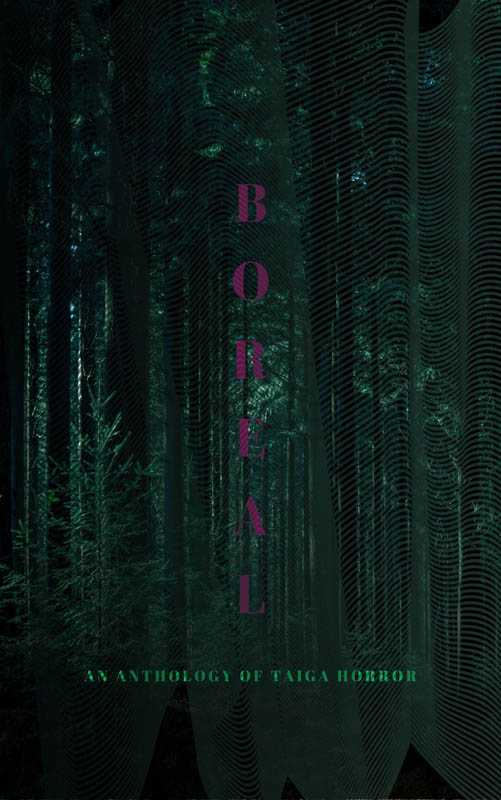
Boreal: an Anthology of Taiga Horror is a collection of twenty-two haunting tales that dwell in the deepest darkest woods and frozen wastelands, edited by Katherine Silva and including Haunted MTL’s very own Daphne Fauber. Each story has even been gifted with its very own poster, hinting at the horrors to be found within it, bestowing a beautiful visual collection as well.
The tales are varied and touch upon the environment in new and different ways, each hearkening to a sort of epiphany or raised awareness. These stories exude both dread and wonder at the smallness of our human existence in contrast to the sacred world we have isolated from, sheltering ourselves in our comfortable houses with centralized heat and everything we could possibly need or want at the ready. The taiga becomes a sanctuary outside of our own dulled awarenesses. It is a holy place imbued with powers beyond mortal human reach, a wilderness that threatens to swallow us – both whole and bit by bit, simultaneously.
The protagonists enter into this realm through ritual, superstition, longing, stubbornness, and their own hubris – yearning to survive its dangers, and to make their own marks upon it. The starkness of their surroundings harbors delicate moments that would be all too easily missed if not deliberately sought or pointed out. The softness of fur, the dappled sunlight shining through trees, the hazy clouds of breath forming in crisp air, the brittleness of bleached bone… those quiet experiences that beg to be forgotten, to lay safely sleeping just below the frozen surface, awaiting spring.
There are those who followed in the footsteps of their predecessors, seeking to escape the constraints of their parent’s and elders’ indoctrination, traditions, madness, and abuse, yearning to find their own way despite also being inextricably bound to their own pasts. There are those who just wanted to go for a walk in the woods, and remained forever changed by what they experienced. There are those who wished to impose their will upon the wilderness, their order falling to disarray, unable to make lasting impact. There are those who sought to leave behind the world of mankind, looking for oneness in the natural order of things through isolation, leaving a bit of themselves behind after being consumed by the terrors they encountered. There are those who truly found communion with the woods, became one with its wildness, and invited its spirit into their hearts to find peace, even at cost of their own lives. And then, there are the spirits themselves…
 (3 / 5)
(3 / 5)
All in all, I give Boreal: an Anthology of Taiga Horror 3.0 Cthulhus. I love existential angst so I found it to be an enjoyable read, and I appreciated the myriad manners in which the biome was explored. But there were points in which I found myself struggling to follow along, as if the words were swept up into their own wilds in ways that alienated myself as reader, as if my mere voyeurism into this otherworldly place was not enough to comprehend the subtle deviations in storytelling mannerisms fully. I suppose in some sense this seems appropriate, but at the same time, it left me feeling a bit unfulfilled, as if I had missed a spiritual connection that should have resonated more deeply.


